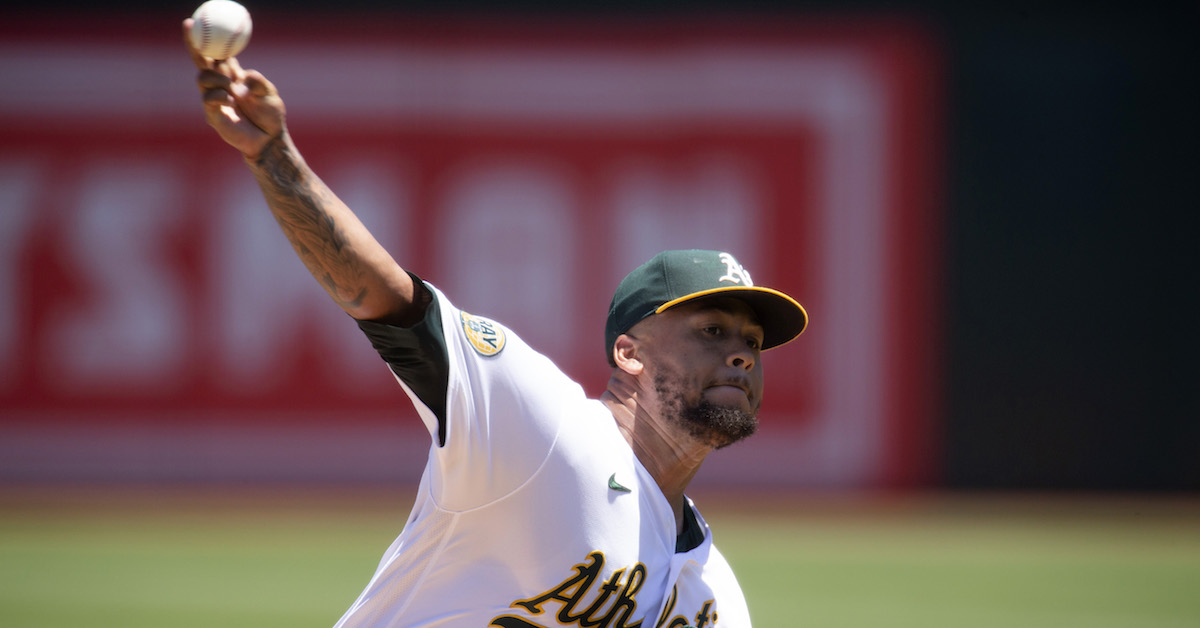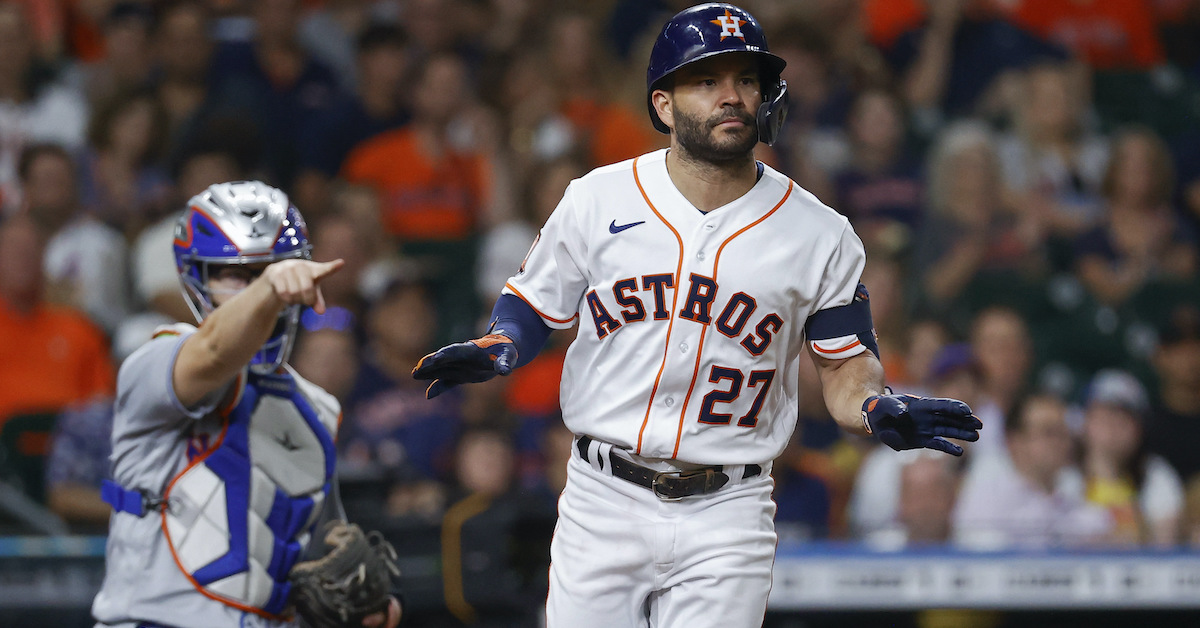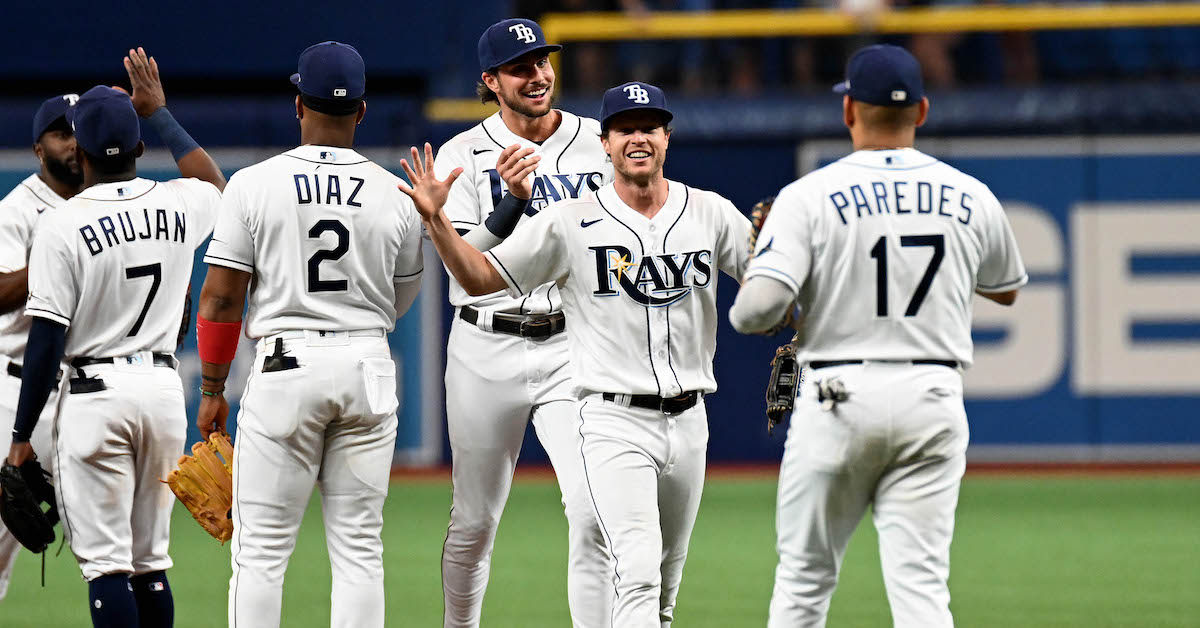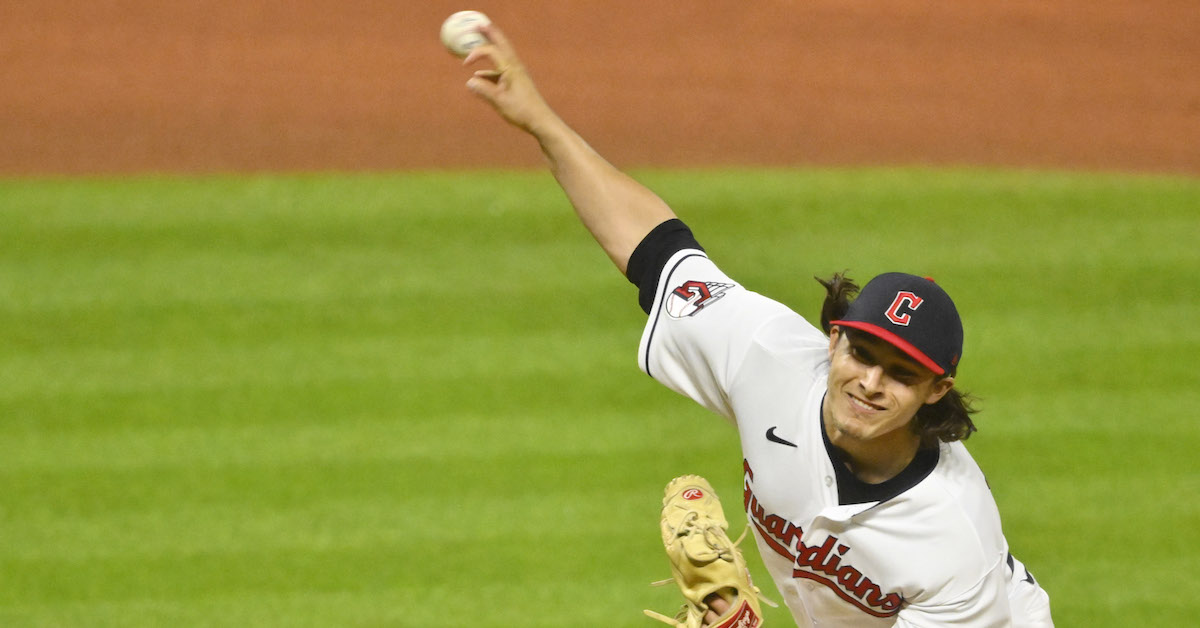Author Archive
Are Returning Pitchers Throwing Harder?

As you might imagine, I watch a lot of baseball for work, and one of the things that stands out to me the most this year is just how dang hard pitchers are throwing. I’m not just talking about that new hotshot reliever your team called up who’s dropping triple digits like peak Aroldis Chapman, though that’s part of it. I’m talking about existing starters, guys I’ve watched for years, adding a little oomph.
Max Fried has topped out over 100 mph this year; his teammate Kyle Wright has never thrown harder. Framber Valdez is up nearly two ticks on average. Carlos Rodón already threw hard, and now he throws even harder. You can’t walk 10 feet without tripping over a pitcher throwing harder than ever – or so it seems to me, a fairly interested observer.
But appearances can be deceiving. I can think of any number of baseball truths that were considered evidently true by observation for years, only to later be disproven. I decided to put my eyes to the test. Have pitchers learned how to throw harder from one year to the next, changing the fundamental truth of how aging works? Let’s find out.
My method is fairly simple. I took every starter who threw at least 10 innings since pitch-level data began in 2008. I took their average four-seam fastball velocity, but only in games they started; I didn’t want to have swingmen who changed roles within or between seasons in my data. From there, I looked at every pitcher to see if he’d thrown in the majors the previous year, and if so, the change in fastball velocity from one year to the next.
In this way, I got a yearly sample of how much every returning pitcher in baseball’s velocity changed, on average, every year. As a quick example, there were 176 pitchers who compiled at least 10 innings as a starter in both 2013 and ’14. On average, they threw 0.21 mph slower in 2014 than they did in ’13. I found those pairs for every year, which gave me a yearly average of velocity changes over time. Read the rest of this entry »
Frankie Montas Stands Alone

Frankie Montas took the mound to start the eighth inning yesterday afternoon with a chance at history. He hadn’t allowed a hit all game, and looked to be picking up steam; his last pitch of the seventh inning hit 99 mph on the stadium gun, one of his hardest pitches of the day. He cut down the first two batters of the eighth in short order – four pitches, two grounders – leaving him only four outs from the first no-hitter of his career.
Montas is one of the best pitchers in baseball. A year ago, he put together his first full season, 32 starts of 3.37 ERA excellence. This year, he’s cleaning things up around the edges: fewer walks, more grounders, and more innings per start. His 3.21 ERA, 3.15 FIP, and 2 WAR are all in the top 20 among starting pitchers.
One small downside: Montas plies his trade in Oakland. That 2 WAR is more than every other player on the A’s has amassed combined (that rest-of-roster total comes in at 1.8 WAR, if you’re keeping score at home). Baseball is a team sport, even if many of the interactions feel individual; Montas sports a 3-7 record despite his sterling numbers. Read the rest of this entry »
Expanding the Strike Zone for Fun and Profit

Ask pretty much any major league hitter, and they’ll tell you that they earn their paycheck with runners in scoring position. A base hit means a run, and you have to score runs to win games. An out — particularly a strikeout — squanders an opportunity to score, and those come vanishingly rarely these days, what with every pitcher in baseball throwing 100 mph with a wipeout slider and all. It’s the highest-leverage spot you can hit in; succeed with runners in scoring position, and your team will probably win, but fail, and it’s going to be a long night.
As far as we can tell, success in those situations — runners in scoring position, high leverage, you name it — isn’t predictive of future success. But that doesn’t mean approach isn’t predictive of future approach, and as you might imagine, hitters behave differently when they can smell an RBI opportunity.
One easy way to conceptualize this change in approach is to think of the edges of the zone and the area just outside of the strike zone — the Shadow Zone, in Statcast parlance — as a good test of what a hitter wants to do. On pitches down the heart of the plate, swinging is a clear best choice. On pitches nowhere near the zone, taking is the only right choice. But pitches that could go either way? The best strategy depends on what you’re trying to accomplish.
With runners in scoring position and no one on first — in other words, a situation where a walk is far worse than a hit — major leaguers have swung at shadow zone pitches 56.4% of the time (in the last two years). On the whole, they’ve only swung 52.9% of the time at those pitches. In other words, they increase their borderline pitch swing rate by 3.5 percentage points when the gap between a walk and a single is the largest.
That’s a rather unimpressive number. It’s the clearest time to swing that you can imagine, and batters are hardly changing their behavior. But that’s logical, when you think about it. Walks aren’t suddenly worthless just because you could drive in a run; juicing up the bases for the next batter still has value. And swinging at borderline pitches is hardly the best way to drive in runs; taking borderline pitches and waiting for a mistake, or for the pitcher to challenge you, might be a better decision.
Read the rest of this entry »
Tampa Bay’s Offensive Depth Is Put to the Test

You can call the Rays unlucky, if you’d like. After amassing the second-most WAR from position players in all of baseball last year, 2022 has been a huge step back. They’re 18th in the league, with an aggregate wRC+ below 100, and injuries have taken a huge toll on the lineup they planned to run out at the start of the year.
Wander Franco, their wunderkind shortstop, hasn’t played since May 30. Brandon Lowe, perhaps the best hitter on the team, has been out two weeks longer than Franco. Manuel Margot had been picking up some of the offensive slack, but now he’s out with a knee injury that may cause him to miss significant time, and fellow outfielder Kevin Kiermaier hit the IL the same day. Mike Zunino was ineffective and is now hurt. Josh Lowe and Taylor Walls, two of the team’s top reinforcements coming into the year, have a combined 51 wRC+. Read the rest of this entry »
Eli Morgan Is Cleveland’s Latest Pitching Revelation

Eli Morgan is one of the best-kept secrets in baseball. He’s not a high-leverage reliever for a marquee team. He’s not even the best or most famous reliever on his own team. Heck, he was a middling five-and-dive starter in the majors just last year. But none of that matters anymore, because now he has a cheat code:
That changeup is absolutely ludicrous. It looks like no other pitch in baseball. It’s slow, much slower than the rest of Morgan’s arsenal. Every other one of his pitches is in the vicinity of league average, while his changeup is the slowest in baseball. That makes for huge separation from his fastball; if the two started on the same trajectory, the changeup would fall 30 more inches than the fastball on its way to home plate. That’s nearly half an Altuve. Read the rest of this entry »
Everything You Want To Know About Three-Pitch Strikeouts… and More

On Wednesday, the Astros easily handled the Rangers. They won, 9–2, with Luis Garcia’s strong start backed by a typically robust offensive performance. The Astros are very good. The Rangers are significantly worse. There are baseball games like this every day, multiple of them even. But this game stands alone, for one singular feat.
Er, well, dual feat. In the second inning, Garcia was simply too much for the Rangers. He faced Nathaniel Lowe, Ezequiel Duran, and Brad Miller, and wasted no time in setting them down:
LUIS GARCIA IS IMMACULATE. pic.twitter.com/9YwSW06uIp
— Houston Astros (@astros) June 15, 2022
That was the 107th immaculate inning — nine pitches, three strikeouts — in baseball history. It wasn’t the most recent one for long, however. In the seventh, Phil Maton came on in relief of Garcia and got right down to business. He faced Nathaniel Lowe, Ezequiel Duran, and Brad Miller, and wasted no time in setting them down:
SAME GAME. SAME BATTERS.
PHIL MATON IS IMMACULATE. pic.twitter.com/xg53FGAJ02
— Houston Astros (@astros) June 15, 2022
Hey, that was really convenient! I got to use the exact same sentence again, because Maton exactly repeated Garcia’s feat; he tore through the three Rangers in only nine pitches for the 108th immaculate inning in history. It was, as you’d expect, the first time the same team has accomplished the feat twice in one game, as well as the first time it’s happened twice on the same day, to give you an idea of how out of the ordinary this was.
You didn’t need FanGraphs to tell you that was remarkable, though. Everyone else already has. Instead, I thought I’d take a look at perfect strikeouts — three pitches, one strikeout, no beating around the bush — and see whether this game still stands out if we remove the “innings” part of immaculate innings.
Garcia had those three perfect strikeouts in the second inning, but he actually managed another one in the game. It was, in fact, the next batter he faced: Leody Taveras went down on consecutive pitches before Marcus Semien took a first-pitch ball to end Garcia’s streak. Four three-pitch strikeouts in a game sounds quite impressive, but it’s not even the most in a game this year. Zach Eflin reeled off six perfect strikeouts in his start on May 22. Six other players have notched five such strikeouts in a game, including Garcia himself on April 22.
Extending our lens backwards in time to 2007, the earliest year in the pitch-by-pitch database I used, you’ll be unsurprised to learn that Max Scherzer holds the single-game record. On May 11, 2016, he tied a far more visible record with 20 strikeouts in a nine-inning game. He also struck out nine batters on exactly three pitches. Scherzer might just have a knack for this; he also notched two separate games with seven three-pitch strikeouts (May 26, 2017 and September 20, 2018).
There have been 11 games since 2007 where a pitcher recorded seven or more three-pitch strikeouts. No one else has more than one. Scherzer, it turns out, is the master of the efficient strikeout. Other good pitchers have approached those heights, but only rarely. Here are those 11 games:
| Pitcher | Game Date | 3-Pitch Ks |
|---|---|---|
| Max Scherzer | 5/11/16 | 9 |
| Corey Kluber | 4/27/18 | 8 |
| Cliff Lee | 6/23/10 | 7 |
| Mat Latos | 6/25/12 | 7 |
| Alex Cobb | 9/16/13 | 7 |
| David Price | 4/22/14 | 7 |
| Ian Kennedy | 9/2/15 | 7 |
| Max Scherzer | 5/26/17 | 7 |
| Carlos Carrasco | 7/7/17 | 7 |
| James Paxton | 5/2/18 | 7 |
| Max Scherzer | 9/20/18 | 7 |
That’s neat, but focusing on that fact highlights only Garcia, and not particularly well at that. If we’re focusing on team perfect strikeouts, the Astros mustered seven; Garcia’s four and Maton’s three were the only ones of the game. That’s part of a three-way tie for most in a single game this year. The Rays notched seven on April 14, and the Astros did it again on April 24. If you’ll recall from above, that’s the game where Garcia had five perfect strikeouts. He’s the standard-bearer for the feat this year.
Zoom out, and things get Rays-y. On August 17, 2019, they struck out ten batters on three pitches apiece, the only team (!) to eclipse Scherzer’s nine-strikeout effort. Houston pitchers certainly looked dominant yesterday, but they needed an entire extra immaculate inning to match the standard Tampa set.
Are you less interested in the specific game and more interested in Garcia’s three-pitch-strikeout prowess? He has 17 of them on the year, which certainly sounds impressive, but only places him in a tie for seventh among pitchers in 2022. Shane McClanahan is first, with a whopping 23. Nestor Cortes, of all people, has 18. Scherzer has 15, and he hasn’t pitched in a month. Garcia is certainly one of the best pitchers in baseball when it comes to going right after the batter and setting them down, but he’s not the best in the business.
Did I succeed in exhausting everyone’s interest in three-pitch strikeouts? Who knows! I find them quite interesting, but then, I find a lot of things about baseball quite interesting. I found yesterday’s Astros feat amazing, but giving it a little more context just makes Scherzer’s feats stand out even more. The three-pitch strikeout is the ultimate expression of pitcher dominance — no waste, just three straight strikes, next please — and it stands to reason that the marquee strikeout pitcher of our generation is also the marquee three-pitch-strikeout pitcher of our generation.
Dakota Hudson, Groundball Enthusiast

Dakota Hudson shouldn’t be this good. It’s hard to analyze baseball, and pitchers are good for all sorts of difficult-to-comprehend reasons, but look at his numbers. It shouldn’t work. His career strikeout rate is a lackluster 17.2%. He walks more than 10% of the batters he faces. Either of those numbers would be alarming; both together is a recipe for trouble.
Naturally, Hudson is off to another roaring start. His 3.29 ERA is actually worse than his career mark, and it’s still 17% better than league average in this low-scoring year. He’s outperforming every available peripheral by miles – just like he always has. Three-hundred-and-fifteen innings into his major league career, his stat line will make you question what you know about ERA estimators. His FIP is a so-so 4.56. It’s not some home run rate fluke, either; his xFIP is exactly the same. SIERA clocks him at 4.96. xERA, the Statcast version of an ERA estimator, is right in line with everything else at 4.55. And yeah… his career ERA is 3.17. So let’s investigate what the heck is going on. Read the rest of this entry »
Skin in the (Ball) Game: Do Teams Underperform When They’re Out of the Race?

Recently, I was listening to one of my favorite non-baseball podcasts when baseball unexpectedly cropped up. Well, the theory of skin in the game cropped up. The idea, espoused by many people but notably by Nassim Taleb, is that actors perform better when they get rewarded for a good outcome and punished for a bad outcome. Want a better doctor? Fine them if they misdiagnose a patient, but give them a bonus for prescribing the correct treatment. Better money manager? Force them to invest all their own money alongside their client. You get the idea.
Anyway, one example of skin not being in the game is a sports team playing out the string. For most teams at most times, sports is a very skin-in-the-game-intensive field. If you hit well, you get paid more. If you don’t, you might get sent to the minors. If your team wins, they make the playoffs. If the team doesn’t win, no postseason. The incentives are straightforward.
At the end of a long season, however, it might not feel that way. If you’re 50-100 in late September, the rewards of a good game aren’t that high, and the cost of a bad game is quite low. If you’re 15 games out in the race, being 16 games out won’t suddenly bring out the detractors. You can think of these teams as having no skin in the game; the result of one game won’t change anything for them. Read the rest of this entry »
Hunter Greene’s New Go-To

Hunter Greene started the 2022 season off with a bang. An audible one, if you were sitting near home plate: Greene topped out at 102.6 mph in his second start of the year, averaged nearly 101 mph on his fastball, and generally looked like an entirely new type of pitcher, a starter with closer velocity.
A funny thing has happened since, though. That fastball didn’t play out quite how you’d expect. After those initial two starts, Greene lost a bit of zip on the pitch, and hitters stopped missing it. He drew 21 swings and misses in his first two major league outings; it took him another six starts to match that total. After walking just two hitters in those first two starts, he walked eight in his next two. It was time for an adjustment.
Consider that adjustment made. In his last seven starts, Greene looks like a top-flight major league starter again. He’s striking out a third of the batters he faces, walking less than 10%, and pitching to a 3.20 ERA (and 3.47 FIP) beginning with his May 10 start against Milwaukee. He’s going deeper into starts. And after the Brewers tormented him for five home runs on May 5, he’s allowed only five in these last seven starts over nearly 40 innings of work. How has the starter with the fastest fastball in the game done it? Exactly how you’d expect – by de-emphasizing his fastball and leaning on his best pitch, an upper-80s slider. Read the rest of this entry »
